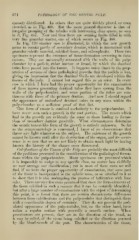Page 864 - My FlipBook
P. 864
874 PATHOLOGY OF THE DENTAL PULP. ;
sparsely distributed. In others they are quite thickly placed, or even
crowded, as in Fig. 469. But the more general character is that of
irregular grouping of the tubules with intervening clear spaces, as seen
in B, Fig. 467. Now and then there are seeming faults filled in with
very fine granular matter, one of which occurs in Fig. 468.
In Fig. 470 another case is illustrated, in which the new growth
seems to consist partly of secondary dentine, which is intermixed with
granular calcific material, calcified tissue, and calcospherite. These two
specimens represent the extremes of tissue-formation occurring in these
tumors. They are universally connected ^fith the walls of the pulp-
chamber by a pedicle, either narrov/ or broad, by which the dentinal
tubes have passed into the tumor. It happens many times in the prep-
aration of sections of these pathological growths that the pedicle is lost,
giving the impression that the dentinal fibrils are developed within the
tissues of the pulp. I cannot but regard this as an error. In every
case in which I have had the proper opportunity for the examination
of these masses presenting dentinal tubes they have sprung from the
walls of the pulp-chamber, and some portion of the tubes are con-
tinuous with those of the primary dentine. And now I should regard
the appearance of undoubted dentinal tubes in any mass Avithin the
pulp-chamber as a sufficient proof of that fact.
This form of tumor is confined exclusively to the pulp-chamber. I
have never seen such a growth in the root portion. The causes which
lead to the growth are evidently the same as those leading to forma-
tions of secondary dentine generally. AVhat circumstances determine
the erratic tumor-like form of the growth is entirely unknown. So far
as the symptomatology is concerned, I know of no observations that
throw any light whatever on the subject. The existence of the growth
cannot be known until after the destruction of the organ, and its occur-
rence is so rare that we are not likely to obtain much light by having
known the history of the chance cases discovered.
Chlcificaiions of the Tissues of the Pvlp are probably the most difficult
of the problems presented in the consideration of the pathological forma-
tions within the pulp-chamber. Many specimens are presented which
it is impossible to assign to any specific class, no matter how skilfully
we may arrange our classification yet in most of these cases we will
;
find, if we have the proper opportunity of examination, that some part
of the tissue is incorporated in the calcific mass, or so attached to it as
to show that it is also undergoing the process of infiltration with lime
salts. There are very few cases presented that show the form-elements of
the tissue calcified in such a manner that it can be certainly identified
but after a large number of examinations with the object of determining
this point, it is fimnd that there are certain characteristic differences
between these calcifications and the pulp-nodules that distinguish them
with a considerable degree of certainty. They do not present the nod^
ulated appearance of the pulp-nodules, but, on the other hand, have
rather a regular outline with generally a smooth surface. When
prominences are present, they are in the direction of the trend, as
it may be called, of the tissue l)eing calcified or the direction pursued
by the blood-vessels of the part. The characteristics of the tissue,


